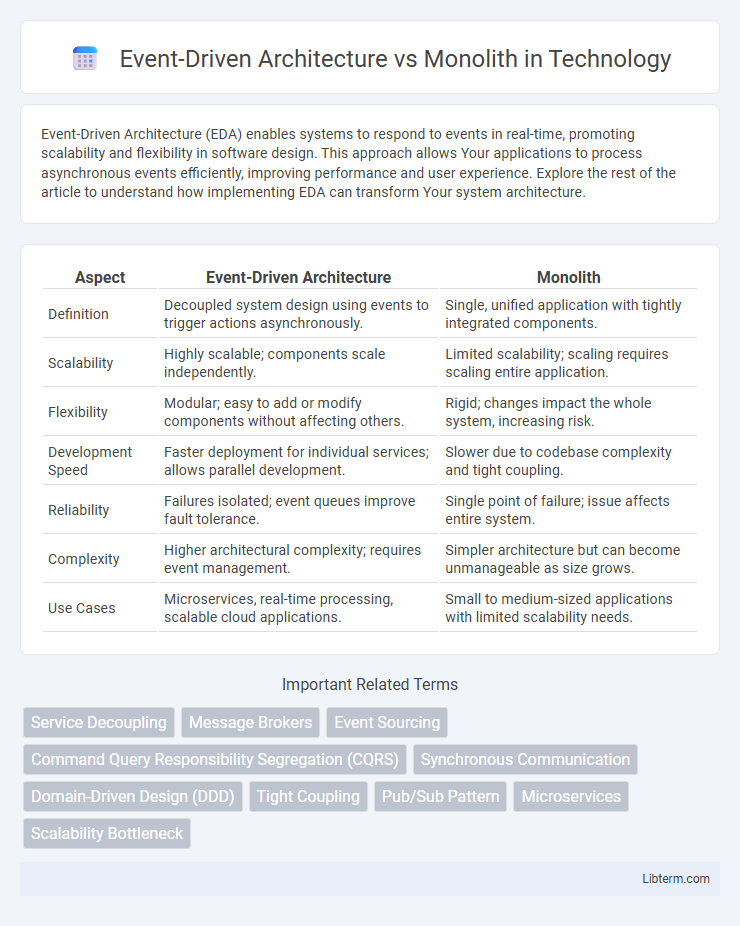Event-Driven Architecture (EDA) enables systems to respond to events in real-time, promoting scalability and flexibility in software design. This approach allows Your applications to process asynchronous events efficiently, improving performance and user experience. Explore the rest of the article to understand how implementing EDA can transform Your system architecture.
Table of Comparison
| Aspect | Event-Driven Architecture | Monolith |
|---|---|---|
| Definition | Decoupled system design using events to trigger actions asynchronously. | Single, unified application with tightly integrated components. |
| Scalability | Highly scalable; components scale independently. | Limited scalability; scaling requires scaling entire application. |
| Flexibility | Modular; easy to add or modify components without affecting others. | Rigid; changes impact the whole system, increasing risk. |
| Development Speed | Faster deployment for individual services; allows parallel development. | Slower due to codebase complexity and tight coupling. |
| Reliability | Failures isolated; event queues improve fault tolerance. | Single point of failure; issue affects entire system. |
| Complexity | Higher architectural complexity; requires event management. | Simpler architecture but can become unmanageable as size grows. |
| Use Cases | Microservices, real-time processing, scalable cloud applications. | Small to medium-sized applications with limited scalability needs. |
Introduction to Event-Driven Architecture and Monolithic Systems
Event-Driven Architecture (EDA) organizes software systems around the production, detection, and reaction to events, enabling asynchronous communication and scalability through loosely coupled components. Monolithic systems consolidate all functions into a single, tightly integrated codebase, which can simplify development but often limits flexibility and scalability. Understanding EDA involves recognizing its benefits in decoupling services and improving responsiveness, while monolithic architectures emphasize unified deployment and straightforward management.
Core Principles of Event-Driven Architecture
Event-Driven Architecture (EDA) centers on decoupling components through asynchronous event communication, enabling scalable and flexible system design. Core principles include event producers generating events without knowledge of consumers, event channels facilitating reliable event delivery, and independent event consumers reacting to events in real-time. This approach contrasts with monolithic architecture, where tightly coupled components hinder agility and scalability.
Key Characteristics of Monolithic Architectures
Monolithic architectures feature a single, unified codebase where all components are interconnected and deployed as one application, leading to simplicity in development and testing but challenges in scalability and maintenance. These systems often suffer from tight coupling, making it difficult to isolate and update individual modules without affecting the entire application. Monolithic designs typically result in slower deployment cycles and hindered agility compared to microservices in event-driven architectures.
Scalability: Event-Driven vs Monolith
Event-Driven Architecture offers superior scalability by enabling independent services to scale horizontally based on specific event loads, reducing bottlenecks inherent in monolithic systems. Monolithic architecture often faces challenges in scaling due to tightly coupled components that require scaling the entire application even when only a single function demands more resources. Event-driven systems enhance responsiveness and resource utilization by dynamically adjusting to demand spikes, making them more efficient in handling variable workloads.
Flexibility and Modularity Comparison
Event-Driven Architecture enhances flexibility by allowing independent service deployment and asynchronous communication, facilitating rapid updates and scalability without impacting the entire system. In contrast, Monolith architecture integrates all components into a single codebase, limiting modularity and making changes more complex and risky due to interdependencies. This modularity in event-driven systems supports better fault isolation and easier integration of new features, outpacing monolithic designs in adapting to dynamic business requirements.
Performance Differences and Considerations
Event-Driven Architecture (EDA) enhances performance by enabling asynchronous communication and decoupled services, which reduces latency and improves scalability compared to Monolithic systems. Monoliths face challenges with performance bottlenecks due to tightly coupled components and limited parallel processing capabilities. When considering performance, EDA supports dynamic load balancing and real-time event processing, whereas Monoliths often require significant resource allocation to handle peak loads efficiently.
Deployment and Maintenance Implications
Event-driven architecture enables independent deployment of microservices, reducing downtime and simplifying maintenance by isolating failures and updates to specific components. In contrast, monolithic systems require complete redeployment for even minor changes, leading to longer release cycles and increased risk of widespread outages. Scalability is more granular in event-driven setups, enhancing resource efficiency and operational agility compared to the monolith's all-or-nothing approach.
Fault Tolerance and Resilience Factors
Event-driven architecture enhances fault tolerance and resilience by decoupling components, enabling independent failure without disrupting the entire system, and facilitating real-time error detection and recovery through asynchronous messaging. In contrast, monolithic architecture often suffers from tight coupling, where a single component's failure can cascade, leading to system-wide downtime and slower recovery times. Event-driven systems leverage distributed processing and redundancy, improving overall system robustness against failures compared to monolithic designs.
Real-World Use Cases and Industry Examples
Event-Driven Architecture (EDA) excels in industries like e-commerce and financial services by enabling real-time processing of transactions and scalable, decoupled services, as seen in Amazon's order processing system and Netflix's streaming service. Monolithic architectures remain prevalent in legacy enterprise applications such as ERP systems used by manufacturing companies, where tightly integrated components simplify deployment and maintenance. Retail giants like Walmart leverage EDA for dynamic inventory management, while traditional monolithic frameworks persist in sectors prioritizing stability over scalability.
Choosing the Right Architecture for Your Project
Choosing the right architecture for your project depends on factors such as scalability, complexity, and deployment needs. Event-Driven Architecture excels in handling asynchronous processes and scaling microservices independently, making it ideal for dynamic, high-traffic applications. Monolithic architecture suits simpler projects with tightly integrated components, offering straightforward development and deployment but limited flexibility for large-scale evolution.
Event-Driven Architecture Infographic

 libterm.com
libterm.com